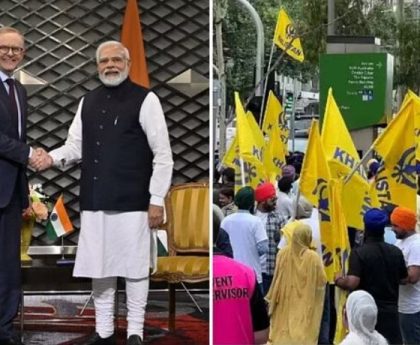The dramatic return of fugitive gangster Anmol Bishnoi to Indian soil has set the stage for what investigators describe as one of the most crucial interrogations in India’s recent battle against organized crime. Bishnoi, the younger brother of incarcerated gangster Lawrence Bishnoi, was deported from the United States after months of diplomatic coordination and was arrested immediately upon landing at Delhi’s Indira Gandhi International Airport. His arrival has triggered a fresh wave of scrutiny surrounding the murder of senior NCP leader Baba Siddique, a case that shook Maharashtra’s political and law-and-order landscape in 2024.
A High-Profile Return Under Tight Security
Security at the Delhi airport was unusually tight. Multiple layers of armed personnel, intelligence officers, and NIA teams had been mobilized long before Anmol’s flight touched down. He was escorted out of the aircraft under heavy guard, with his face partially covered but unmistakably tense as cameras flashed around him. His deportation was the result of months of cooperation between U.S. agencies and Indian counterparts after his asylum plea was rejected in America.
Once the legal documentation was completed, the NIA formally arrested him under the stringent Unlawful Activities (Prevention) Act (UAPA) and other criminal provisions. Within hours, he was produced before a special court, where investigators secured extended custody to question him about the vast criminal web he is believed to have operationalized from overseas.
The Murder That Sparked a Nationwide Outcry
At the heart of the NIA’s investigation is the violent assassination of former Maharashtra minister Baba Siddique, who was gunned down outside a political event in Mumbai in October 2024. The murder sent shockwaves through the state, not only because of Siddique’s political influence but also due to the audacity of the attack.
Early investigations revealed that the killing was not a spontaneous act but a carefully planned execution allegedly orchestrated by the Bishnoi crime syndicate. The gang reportedly used local shooters, but the command, funding, and logistics were believed to have been coordinated by Anmol from abroad.
With his arrest, investigators hope to establish:
- The identity and role of each conspirator in the murder plot
- The financial networks used to pay the shooters
- The international connections that helped Anmol evade arrest for years
- Any political or rival-gang motives behind the hit
A Global Criminal Network Under the Microscope
Anmol’s alleged operations were not limited to the Siddique case. For years, he has been suspected of running a shadow network of extortion, contract killings, smuggling, and intimidation using digital anonymity, encrypted communication apps, and fake passports.
Despite staying abroad — first in Southeast Asia, then in Africa, and finally in the United States — he continued to exert influence over his brother’s gang. Intelligence agencies believe he acted as the gang’s foreign-based strategist, handling:
- Cross-border movement of funds
- Recruitment of hitmen from multiple states
- Management of illegal arms shipments
- Coordination with other international crime syndicates
- Digital propaganda and threats issued through social media
His interrogation could shed light on transnational crime patterns that have concerned Indian security agencies for the past decade.
A Long History of High-Profile Crimes
Anmol’s name has appeared in several FIRs across multiple Indian states. Apart from the Siddique murder case, law enforcement links him to:
- The Sidhu Moosewala murder conspiracy in 2022, in which he allegedly coordinated shooters and helped arrange logistics.
- The firing outside Salman Khan’s residence in Mumbai, believed to be an intimidation act.
- A series of extortion cases involving businessmen, real estate developers, and celebrities.
- Multiple social-media threats in which he claimed responsibility for attacks or warned rivals.
The NIA believes that by piecing together his involvement in these cases, they can dismantle a larger ecosystem of organized crime intertwined with terrorism and illegal arms trade.
Months of Pursuit Culminate in Deportation
After fleeing India in 2022, Anmol used multiple fake identities to hop across borders. He reportedly stayed in Cambodia, Turkey, Kenya, South Africa, and finally entered the United States illegally. His asylum claim — based on alleged threats to his life — was rejected by American authorities.
His arrest in the U.S. last year was followed by long legal procedures, after which Indian agencies finally secured his deportation. The operation, coordinated between Indian consular officials and U.S. Homeland Security, was executed discreetly to avoid tipping off criminal associates.
What the NIA Hopes to Extract
Investigators have outlined a detailed interrogation plan that covers several critical areas:
- Foreign Financing Channels:
Tracing how the gang earned and moved money abroad, including hawala routes and crypto-based transfers. - International Safehouses & Contacts:
Mapping all foreign operatives, including those who provided shelter, arms, or forged papers. - Digital Footprints:
Recovering encrypted chats, voice notes, and email trails that may prove conspiracy and coordination. - The Baba Siddique Murder Plot:
Identifying masterminds, financiers, and the motive behind the killing. - Potential Terror Links:
Ascertaining whether the gang collaborated with banned organizations for arms or funding.
The NIA believes that Anmol’s cooperation — voluntary or otherwise — could lead to multiple arrests both in India and overseas.
Political Reactions and Public Pressure
The return of Anmol Bishnoi has triggered strong reactions from political circles. Members of the Siddique family publicly welcomed the development, expressing hope that justice would finally be delivered. Opposition leaders, meanwhile, demanded that investigators probe whether any political figures had indirectly benefited from or supported the crime syndicate.
Public interest in the case remains high, particularly because of the Bishnoi gang’s notoriety and its past involvement in celebrity-related crimes.
The Road Ahead
With Anmol now in custody, the NIA’s focus will shift to:
- Breaking down the gang’s hierarchy
- Freezing illegal assets both in India and abroad
- Filing supplementary chargesheets
- Seeking cooperation from foreign security agencies
The case is likely to remain in the spotlight for months, if not years. For now, the Indian government views the deportation as a major victory in its ongoing crackdown on organized crime with global tentacles.




